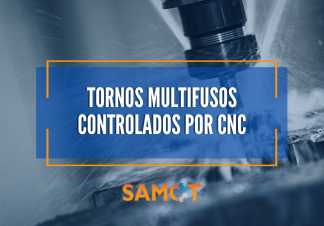
Multi-Spindle CNC Lathes vs. Cam-Driven Lathes
Automatic lathes emerged in the late 19th century, driven by cam-operated mechanical machines, improving productivity, precision, and stability due to the developments that have occurred throughout history. Today, we find machines in this category equipped with one or more CNC carriages or with all CNC actuations.
The lathe is a highly versatile machine tool used in the manufacturing, repair, and finishing of parts, with just two adjusted movements: the rotation of the fixed piece and the tool's advancement on the workpiece's surface. On the other hand, the Multi-Spindle lathe, as the name suggests, is a machine composed of multiple spindles inserted in a drum that feeds bars and changes position to perform simultaneous operations on the product in a fractionated manner. In other words, each spindle position carries out an operation, and the cycle time becomes the bottleneck operation time.
But what are the advantages of CNC-controlled multi-spindle lathes compared to cam-driven models?
- The ability to perform more complex operations without the need for subsequent operations: Cam-driven multi-spindle lathes work on a single axis and mostly have 5 positions for front-end operations and 6 positions for cross operations, which limits the number of possible operations. CNC-controlled multi-spindle lathes, on the other hand, offer greater flexibility, allowing for more complex operations without the need for additional steps.
- . Shorter setup time: Cam-driven multi-spindle lathes require the exchange of various mechanical components during setup, such as cams, carriages, scales, etc. In CNC-controlled lathes, only cutting tools and the CNC program need to be replaced, significantly reducing setup time.
- The ability to use standard tools: Cam-driven multi-spindle lathes require special tools that replicate the final shape of the part to perform the operation. CNC-controlled lathes, with the ability to copy the product profile through the CNC program, can use commercial tools, reducing tooling costs.
- Operator training: Cam-driven multi-spindle lathes require more specialized labor for setup and, even during operation, if dimensional corrections are needed. In CNC-controlled lathes, these tasks are simpler to perform, and more common labor, such as that of a conventional CNC lathe, can be used.
SAMOT SAMOT has a variety of multi-spindle machines in its manufacturing facility, including cam-driven machines, those with one or more CNC carriages, and a large number of CNC-controlled multi-spindle machines. This makes us well-prepared for high demands and diverse markets that require complex operations with shorter processing times and greater process flexibility, ensuring precision, quality, and productivity..

